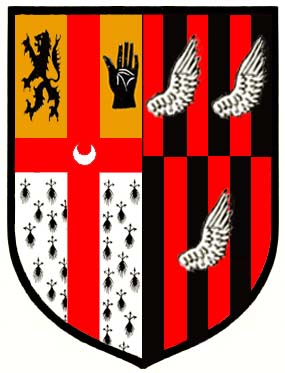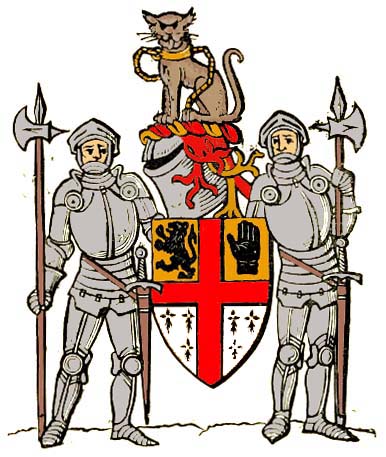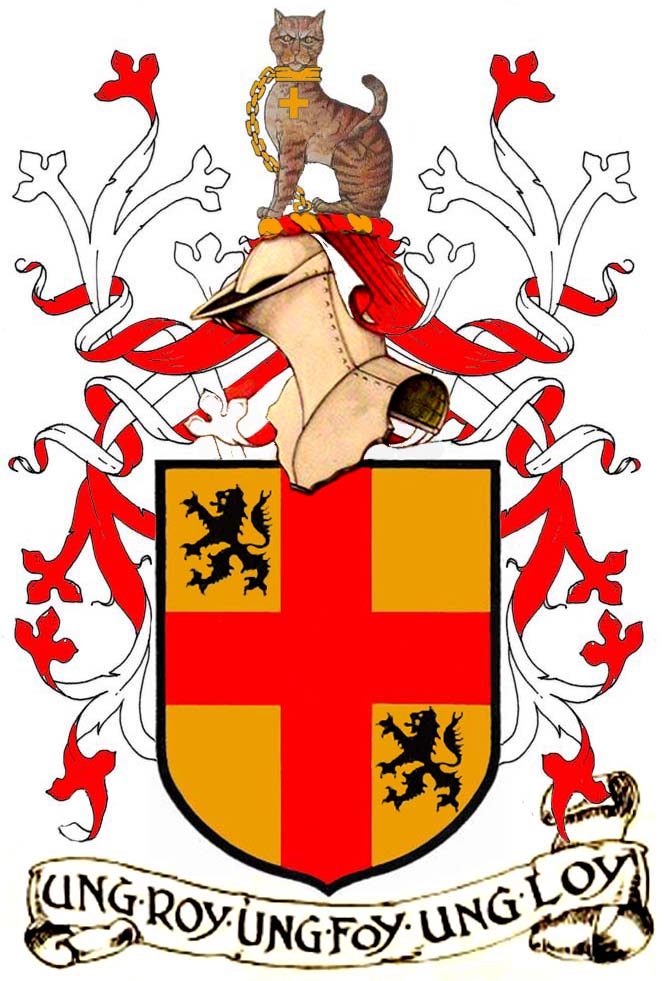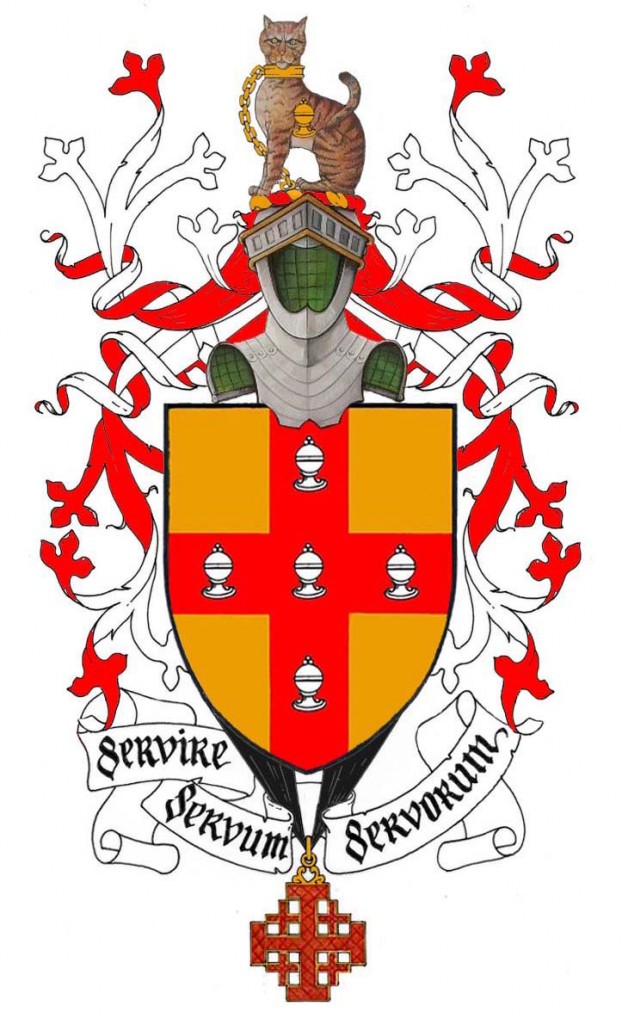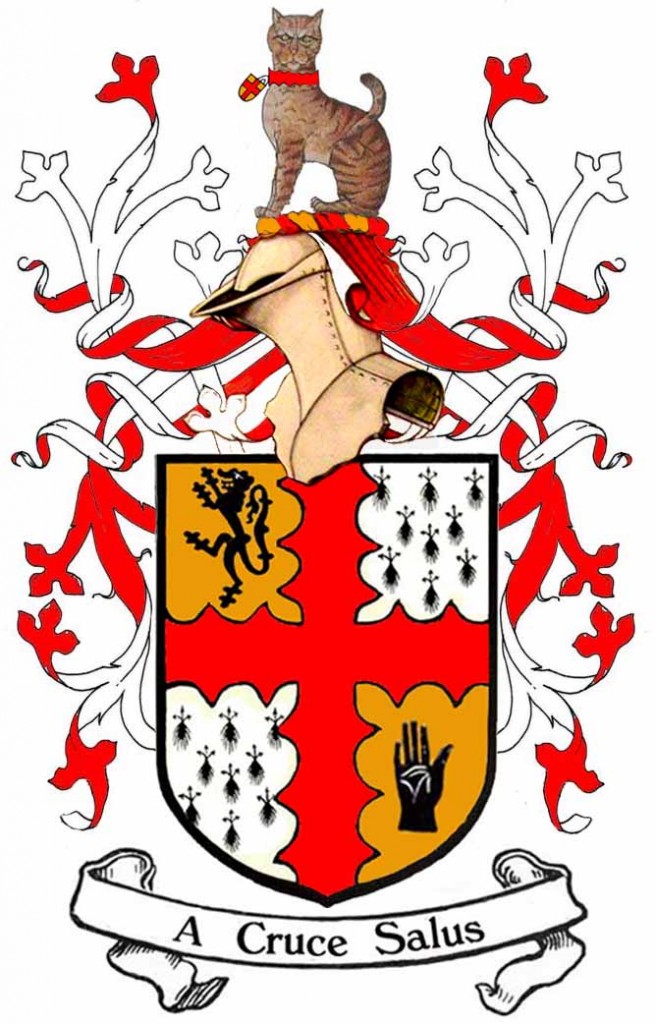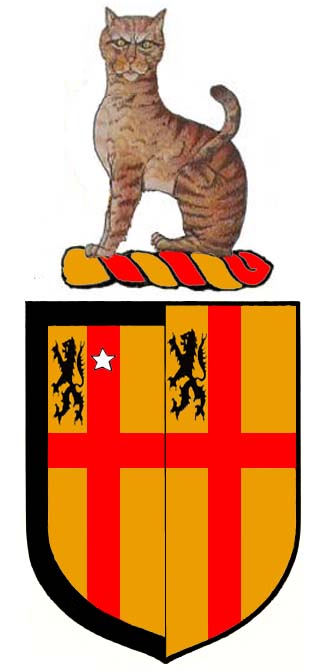© Donal G. Burke 2013
Variations to the shield
The basic or pronominal shield associated with the name Burke, Bourke or de Burgh has come to be regarded as ‘Or a cross Gules’ although it would appear this was not borne by at least the earliest two generations of the name in Ireland. (Refer to Burke, Part I)
The oldest known and most identifiable of variations upon this are the arms of the Earls of Clanricarde, who bore a lion rampant Sable in the upper dexter canton or the arms of the MacWilliam Iochtar (the chieftain of the Mayo Bourkes) and Bourkes of Castleconnell, who were attributed Or a cross Gules but with a hand couped at the wrist in the upper dexter canton. (The Viscounts Bourke of Mayo, descendants of the MacWilliams Iochtar would also be attributed similar arms but with the addition also of a lion rampant Sable in the upper dexter canton and the hand in the sinister.)
Later use of the ‘Or a cross Gules’ without charges
The basic shield, Or a cross Gules, was associated with the mainline of the de Burgh Earls of Ulster and Lords of Connacht, the last of whom was murdered in 1333.
Among the few who in later years came to use arms of simply ‘Or a cross Gules’ were the Burghs of Dromkeen in County Limerick and of Bert and of Oldtown, the latter two in County Kildare. The family of Bert descended from Captain William Burgh of Bert, who died in 1744 while that of Oldtown descended from Thomas Burgh of Oldtown, Engineer and Surveyor General, given in one source as second and third sons respectively of Rt. Rev. Ulysses Burgh of Dromkeen, who died in 1692, Protestant Bishop of Ardagh. Dromkeen was given by that same source as inherited by the Bishop’s eldest son Rev. Richard Burgh of Dromkeen. The Bishop and the families of Dromkeen, Bert and Oldtown are reputed to be descended from one John Bourke of Shrule, County Mayo, who settled at Dromkeen, son of Walter Bourke of Shrule who died of plague in 1440, MacWilliam Iochtar or chieftain of the Mayo Bourkes and grandson of Sir Edmond Albanach de Burgh, but it is also thought possible that they descend of a minor branch of the wider Castleconnell family. In either case, it is reputed that one Rickard of this family, who flourished in the early to mid seventeenth century, was the first to commonly use the name Burgh as an anglicised form of the surname as opposed to Bourke about the time of his embracing Protestantism and taking holy orders. This Rickard was given in some, but not all, sources as father of Ulysses, Bishop of Ardagh.[i] The name continued in use as Burgh until the mid nineteenth century when, in 1848, Sir Ulysses Burgh, 2nd Baron Downes, who died in 1863 and his cousins, Thomas Burgh of Oldtown, Rev. Walter Burgh, vicar of Naas, Major John Burgh and Rev. William Burgh were authorized to assume the name de Burgh.[ii]
As descendants of Bourke of Shrule or of Castleconnell, the arms historically associated with this family included at least the hand couped at the wrist in either of the upper cantons but they appear to have come to bear the earlier ‘Or a cross Gules’ without a charge based on their use of the surname Burgh and later de Burgh rather than on a descent from the mainline of the Earls of Ulster.
The differencing between various armigers and branches
Other than the use of marks of cadency (ie. small symbols to identify the hierarchy of sons of a common father), heralds have taken a number of approaches to the differencing of arms of individual armigers of the name Burke. In general this has involved;
- Variations to the field, in whole or in part
- The addition of charges in the cantons
- The placing of charges to the cross
- Variations to the cross
- The addition of a bordure or similar
Variations on the field, in whole or in part
One of the earliest examples of a change in field to differentiate between senior branches of the name is that of the Viscounts Bourke of Mayo. Theobald 1st Viscount Bourke of Mayo died in 1629 and his funeral entry in the office of the Ulster King of Arms displayed his arms, beneath a coronet of rank, as ‘Per fess Or and Ermine, a cross Gules, in the dexter canton a lion rampant Sable and in the sinister a hand couped at the wrist Sable’ and impaled with those of his wife’s family of O Connor Sligo.[iii] (His funeral entry did not display a crest or supporters.)[iv] His immediate descendants bore the same shield divided ‘per fess Or and Ermine’ about the cross.
The shield of David Bourke, merchant, of Dublin, who died in July of 1630, second son of Sir Theobald, 1st Viscount Bourke of Mayo. Married to Mary, daughter of Nicholas Heward, ‘sometime Chamberlain of the Exchequer by whom he had issue,’ his impaled arms in his ‘Funeral Entry’ show those of the Viscounts Bourke of Mayo on the dexter side and those of Heward on the sinister, with a crescent on the Bourke arms as a mark of cadency to identify him as the second son.[v]
Shield, helmet, crest and supporters of Dermot Robert Wyndham Bourke, 7th Earl of Mayo and Viscount Mayo, born in 1851, after Joseph Foster’s ‘Peerage of the British Empire for 1882,’ showing the shield divided per fess Or and Ermine.
Another family whose arms also involved a variation to the field was that of the Burkes of Marble Hill in County Galway. The lion rampant was used in the upper dexter canton as the sole charge by the senior-most member of this family, although there is no definitive evidence of direct descent from the Earls of Clanricarde. (This would not preclude their possible descent from an early chieftain of the Burkes of Clanricarde, but again there is no definitive proof to this effect.) This family emerged from the position of minor landholders in the south east of County Galway in the early seventeenth century to become significant landowners in that region and baronets of Ireland in the eighteenth.[vi] This branch came to bear ‘Erminois, a cross Gules in the upper dexter canton a lion rampant Sable.’ Their principal seat in the parish of Ballynakill in South East Galway was burned in the early twentieth century in the Irish Civil War and the estate was eventually sold and the family removed to England where the line of the baronetcy continued.
The arms of Sir Henry George Burke, 5th Baronet, of Marble Hill, County Galway, Deputy Lieutenant and High Sheriff of that county 1883, displaying the hand Gules upon a field Argent badge of a baronet, after those arms illustrated in ‘Debrett’s Baronetage, Knightage and Companionage, 1893.’
Variation by the addition of charges in the cantons
The inclusion of additional charges in the cantons was an approach used in the arms of the family of Peter Joseph Burke of Elm Hall, County Tipperary, Serjeant-at-Law, Q.C. for the County Palatine of Lancaster, eldest son of John of Thistle Grove, Middlesex and of Gower Street, London, grandson of Peter Burke of Elm Hall, Co. Tipperary. This branch of the wider family descended from one Dominick Burke, born about 1664 and seated at Clondegoffe Castle in south east County Galway, on the shores of Lough Derg, who family tradition claimed descended from the Clanricarde family through the Burkes of Meelick and Tintrim in the parish of Clonrush (formerly in south east Galway and later located within the modern confines of County Clare).[vii]
The Burkes of Elm Hall, near the villages of Carrig and Riverstown, County Tipperary, were a junior line descended from Dominick of Clondegoffe’s second son Peter of Parsonstown (ie. Birr) in King’s County, who married a daughter of Henry Comerford of Faddanbegg (near the village of Carrig and town of Birr). Dying in 1764, he was ancestor of the Burkes of Rockville and Clongowna and Elm Hall, all in north County Tipperary and all in close proximity to Parsonstown, Kings County (ie. modern town of Birr, County Offaly) in which churchyard members of succeeding generations of this family were buried.
Peter Joseph Burke of Elm Hall, together with his descendants and those other descendants of his grandfather Peter Burke, was confirmed arms of ‘Or a cross Gules, in the first and fourth quarters a lion rampant Sable.’ The crest of this family was that of a ‘cat a mountain sejant guardant Proper collared and chained Or’, charged with a cross Or upon the breast of the cat for differentiation from other branches.[viii]
Peter Joseph’s father, John, settled in London in 1811 and was the author a number of genealogical and heraldic works such as ‘Burkes Peerage and Baronetage’ and ‘The Commoners.’ A number of his immediate descendants pursued a similar path and went on to found a family intimately connected with heraldry in Great Britain and Ireland. Peter Joseph died unmarried in London in 1881. His next eldest brother, John Bernard Burke, called to the bar in 1839, was author of numerous genealogical works, including ‘Burke’s Peerage and Baronetage,’ ‘Commoners,’ ‘Landed Gentry’ and others. Knighted in 1854, he went on to become Ulster King of Arms and Registrar and Knight Attendant of the Order of St. Patrick, Keeper of the State Papers of Ireland and Governor and Trustee of the National Gallery of Ireland.[ix] As a beneficiary of the confirmation of arms to his elder brother and the other descendants of their common grandfather, he and his descendants likewise bore the same two lions Sable upon their shield and the same crest.
Sir John Bernard Burke, Knt., C.B., LL.D., M.R.I.A., Ulster King of Arms, died at his residence, Tullamaine in County Dublin, in 1892. Among his seven sons, the eldest, Sir Henry Farnham Burke, K.C.V.O., C.B., F.S.A. became Rouge Croix Pursuivant of Arms in ordinary (an officer of the College of Arms), Somerset Herald, Norroy King of Arms and rose to become Garter Principal King of Arms in 1919. Bernard Louis, the second son of Sir John Bernard, became Athlone Pursuivant of Arms and the sixth, John Edward, also came to hold the same office as the latter.[x] Ashworth Peter Burke of Elm Hall, fourth son of Sir John Bernard Burke, succeeded his father as editor of ‘Burke’s Peerage and Landed Gentry.’
Sir John Bernard Burke, in associating his ancestors of Clondegoffe Castle with descent from the Burkes of Meelick, in at least one reference gave their late sixteenth century ancestor as John Burke, Baron of Leitrim, son of Richard, 2nd Earl of Clanricarde. This John, Baron of Leitrim was described by Sir John Bernard Burke as ‘of Meelick’ but this would appear to be an incorrect attribution, as there is no evidence that John ever resided there and only jointly with his father held a lease of Meelick castle and manor from the Queen from December 1570 to Michaelmas 1576 prior to their forfeiture of the same for failure to pay rent during that period.[xi] (In 1577 Meelick was then leased to one John Vawse, gent.)[xii] The family pedigree appears to have erroneously equated this Meelick Castle in the east of County Galway (in the modern parish of Meelick, barony of Longford) with another Meelick which, although now in County Clare, once lay within the barony of Leitrim in south east County Galway prior to nineteenth century country boundary alterations.
Late in the seventeenth century a Burke family was seated at this latter Meelick, in the parish of Clonrush (now in County Clare) near the village of Whitegate, with Richard Burke of Meelick and Dorkish, his mother subject to Cromwellian transplantation in the middle of the century.[xiii]
This, however, does not preclude the descent of the family of Elm Hall from the Clanricardes, who held Clondegoffe Castle for a considerable period of its history, but it appears unlikely that this John Burke, Baron of Leitrim, murdered in 1583, ever resided at either Meelick.
The Burkes of Auberies, Sudbury in Suffolk were a more senior line of this Burke branch, descended from James St. George Burke, Q.C., of the Middle Temple and Auberies, who died at the age of about seventy-seven years in 1881, third son of John French Burke of London, merchant, only son of Joseph Burke of Upper Baker Street, Portman Square, London, merchant (died 1827), elder brother of Peter of Elm Hall, son of John and grandson of Peter of Parsonstown (ie. Birr), Kings County, son of Dominick of Clondegoffe Castle.[xiv] This branch also bore the cross couped Or upon the cat a mountain crest and same motto as that of Elm Hall, suggesting that this was taken as the crest of the common ancestor of Elm Hall and Auberies; that Peter Burke of Parsonstown, Kings County who died in 1764.[xv]
The arms of Ulick John Burke, Esquire, Bachelor of Arts of the University of Oxford, J.P. for the Counties of Essex and Southampton, sometime Captain, Suffolk Yeomanry Cavalry, Barrister-at-Law, born in 1843, fourth son of James St. George Burke, Esq., Q.C., of Auberies, Sudbury in the County of Suffolk, after those illustrated in Fox-Davies’ ‘Directory of Gentlemen of Coat-Armour, 1905. No mark of cadency was given indicating his position among the sons of his father.
The arms of James Patrick McRickard, Esquire, born in 1872, is an example of additional charges being placed in the cantons to differentiate not only branches of the name Burke but also those to whom descent from the de Burghs was attributed. Fox-Davies in his ‘Armorial Families’ gives McRickard’s arms as ‘Or a cross Gules, in the dexter canton a lion rampant Sable and in the sinister a lymphad Proper.’ For crest he bore a cat a mountain sejant guardant Sable collared and chained Or. For motto he bore ‘Un Roi, un foi, un loi.’[xvi]
Another example of arms granted to an individual believed to be descended from a de Burgh or Burke ancestor, although no longer bearing that name, is that of the arms granted in 1954 to the Most Reverend William J. Philbin, Roman Catholic Bishop of Clonfert by the Chief Herald of Ireland. In this case again a variation employing charges in various cantons on either side of the cross Gules was used. These arms consisted of a shield ‘Or on a cross Gules between in the first quarter a lion rampant and in the fourth quarter a dexter hand couped at the wrist Sable, an antique scroll with seven broken seals Proper.’[xvii] During his time as Bishop of Clonfert he used these arms impaled with those of the Diocese of Clonfert, with the latter on the dexter side of the shield.
A native of Kiltimagh, County Mayo, Dr. William J. Philbin, was ordained for the diocese of Achonry, a Professor of Dogmatic Theology in Maynooth from 1937 to 1953, was appointed Bishop of Clonfert in December of 1953 and consecrated the following year. He served as Bishop of Clonfert until 1963, in which year he was provided to the diocese of Down and Connor.[xviii]
Two distinct families of the name Philbin arose from northern Connacht, from the region later defined as County Mayo. While one emanated from the baronies of Erris and Tirawley as a branch of the wider Barrett family, another, as the Clan Philpin, a branch of the wider de Burgh or Burke family, are reputed to derive their decent from one John, son of Philip, a younger son of that William óg de Burgh killed at Athanchip in 1270, son of Richard, first de Burgh Lord of Connacht. The latter, as a Gaelicised sept were established in the baronies of Burrishoole and Carra in the late medieval period, the head of which was known as the MacPhilibin. Their common descent with others of the name Burke was not forgotten and when John MacOliver Burke, the chieftain of the Mayo Burkes or MacWilliam Iochtar came before Sir Henry Sidney in 1576, Sidney noted that he brought with him all his brethren, together with ‘MacPhillippin, who in surname is a Bourke, as he is.’[xix] In granting Bishop Philbin arms composed of a variation of those used in the late sixteenth century by the MacWilliam Iochtar, chieftain of the Mayo Bourkes, the Chief Herald of Ireland associated the Bishop with the latter family of Philbin.
Variation by the placing of charges upon the cross Gules
The vast majority of grants and confirmations of arms made by the Ulster King of Arms and Chief Herald of Ireland to armigers of the name Burke involved the placing of charges in one or more of the cantons about the cross Gules rather than on the cross.
An early example of differencing between branches bearing ‘Or a cross Gules’ by the placing of charges upon the cross occurred in the Bigod family, with the mainline Earls of Norfolk bearing the simple uncharged cross and Ralph of Settrington in Yorkshire bearing ‘Or on a cross Gules five escallops Argent.’ The same arms of five escallops were ascribed to Sir Raffe Bigod of Norfolk and one John Bigod in the medieval period.
Within the context of those armigers of the name Burke, one of the few examples of arms granted with charges upon the cross is ‘Or on a cross Gules five covered cups Argent’ granted by the Chief Herald of Ireland to Donal Gerard Burke K.C.H.S., Bachelor in Architecture, eldest son of Daniel Burke and Nora Burke alias Cunningham of Killaltanagh, parish of Clonfert, County of Galway.[xx]
Arms of Donal Gerard Burke, Knight Commander of the Equestrian Order of the Holy Sepulchre of Jerusalem, eldest son of Daniel Burke of Killaltanagh, parish of Clonfert, County Galway, after those granted by the Chief Herald of Ireland, N.L.I., Dublin, G.O., Ms. 111, Vol. Aa, Fol. 37.
The grant as exemplified on the letters patent depicts a knight’s helmet above the shield, borne affronté with open visor and mantled Gules doubled Argent. Upon a wreath of the colours for crest, a cat a mountain sejant guardant Proper collared chained and charged on the side with a covered cup Or. Suspended below the shield is the insignia of a Knight Commander of the Equestrian Order of the Holy Sepulchre of Jerusalem.[xxi] An example of a grant with ‘special remainder’, it extended to his descendants and the other descendants of his father, ‘each using their due differences.’
Variations to the cross
One of the few grants of arms involving a variation to the cross on the shield are the arms granted by Sir Arthur Vicars, Ulster King of Arms, in April 1902 to Edmund Francis Bourke of Pretoria,Transvaal Colony, Gentleman. In this case the cross Gules was engrailed while his family origin in County Mayo would appear to have been acknowledged by the inclusion of the ermine field and the dexter hand couped Sable associated with the arms borne in the early seventeenth century by the Viscounts Bourke of Mayo. His arms were blazoned ‘Quarterly Or and Ermine, a cross engrailed Gules, in the first quarter a lion rampant and in the fourth a dexter hand couped at the wrist Sable, for crest, on a wreath of the colours, a cat-a-mountain Proper, gorged with a collar engrailed Gules, pendent therefrom an escutcheon Or, charged with a cross of the second and for motto ‘A Cruce Salus.’
Arms granted by Ulster King of Arms on 30th April 1902 to Edmund Francis Bourke of Pretoria, Transvaal Colony, Gentleman, eldest son of John Bourke, third son of Patrick Bourke of Kanturk, County Mayo, Esquire, eldest son of Patrick Bourke of Kanturk, County Mayo. The arms were granted to Edmund Francis Bourke, his descendants and the other descendants of his father John Bourke, ‘with their due and proper differences according to the Law of Arms.’ N.L.I., Dublin, G.O. Ms. 111, Grants and Confirmations of Arms, Vol. J, 1898-1909, Fol. 117.
Variation by the addition of a bordure or similar
The addition of a border or ‘bordure’ about the shield is noteworthy as a rare means of differentiation in Burke arms. One of these few armigers, however, recorded with arms bearing a bordure was Henry Burke of Clough, gentleman, third son of Sir Hubert Burke of Glinsk, who died in November 1635 and was buried in St. James’ Churchyard, Dublin. Married to Mary, daughter of Thomas Burke of Tubirry, County Galway, by whom he had five sons and five daughters, his funeral entry in the records of the Ulster King of Arms shows his arms impaled with those of his wife’s family. On the dexter half of the shield his own arms are shown as ‘Or a cross Gules in the dexter canton a lion rampant Sable surrounded by a bordure Sable’ and at honour-point a mullet to indicate his position as the third son.[xxii] On the sinister half his wife’s family arms are shown simply as ‘Or a cross Gules in the dexter canton a lion rampant Sable. His arms are noteworthy in that the greater majority of armigers of the family of Glinsk did not carry a bordure upon their shield and are commonly attributed a crest of feather emanating from a ‘coronet’ while Henry of Clough’s crest was described in his funeral entry as ‘Clanricard’s crest without chain or collar’, implying a cat a mountain. No motto or illustration of the crest was given in the funeral entry.
The impaled arms of Henry Burke of Clough, County Galway, gentleman, who died in 1635, third son of Sir Hubert Burke of Glinsk, County Galway, as given in his Funeral Entry, showing the bordure Sable on the dexter side of the shield. The crest of a cat a mountain Proper without collar or chain was described in that Funeral Entry but not illustrated.
[i] Burke, B., A genealogical history of the dormant, abeyant, forfeited and extinct peerages of the British Empire, London, Harrison, 1866, p.91; N.L.I. Dublin, G.O. Ms. 170, Registered Pedigrees Vol. 16, c. 1816-1817, pp. 1-4. This family pedigree, certified by Ulysses Burgh of Bert in 1818, displayed the arms as Or a cross Gules with a crest of a cat a mountain sejant Proper and a motto of ‘Un Roy Une Foy Une Loy.’ The exemplification was amended in pencil to show the cat chained and the motto amended to read ‘a cruce salus.’ The same family pedigree did not show a clear line between Rt. Rev. Ulysses Burgh D.D., Lord Bishop of Ardagh and the preceding generation, giving as his possible father one Edmond Burgh of Dromkeen. This pedigree also gave the Bishop’s eldest son as Captain William Burgh of Bert, his second as Thomas of Oldtown and third son as Reverend Richard Burgh of Dromkeen, who died between 1735 and 1739. William Betham Ulster King of Arms in another pedigree of the wider family amended the earlier pedigree and gave as father of Rt. Rev. Ulysses Burgh, Lord Bishop of Ardagh who died in 1692 one Rev. Ulysses Burgh of Dromkeen, ‘Minister of the Gospel’ in 1656, son of Ulick or Ulysses Burgh of Dromkeen, second son of Richard Bourke of Dromkeen, descended but not in a clearly recorded line from Meyler son of William duff of Dromkeen.(N.L.I. Dublin, G.O. Ms. 169, Registered Pedigrees Vol. 15, c. 1813-1839, pp. 187-191.) This last pedigree gave Rev. Richard Burgh of Dromkeen, Chantor of Emly, who died between 1735 and 1739 as the elder brother of both Captain William Burgh of Bert and Thomas Burgh of Oldtown, M.P., Engineer and Surveyor General.
[ii] Burke, B., Genealogical and heraldic dictionary of the peerage and baronetage of the British Empire, London, Harrison, 1865, p. 351.
[iii] Lodge, J., Archdall, M., The Peerage of Ireland, or, a genealogical history of the present nobility of that kingdom, with engravings of their paternal coats of arms, James Moore, Dublin, 1789, Vol. IV, p.236.
[iv] N.L.I. Dublin, G.O. Ms. 68 Funeral Entries, p. 147. The children of the first viscount were given in his funeral entry as Rt. Hon. Miles Viscount Bourke, David, Theobald, Richard, Mary, Onora and Margaret. He was buried at Ballintubber, County Mayo.
[v] N.L.I. Dublin, G.O. Ms. 68 Funeral Entries, p. 154; G.O. Ms. 79 Funeral Entries, p. 159. His impaled arms in the second Entry omit the crescent.
[vi] Sir William Burke Teeling, writing in 1932, referred to the Burkes of Marble Hill as ‘only descended from a Burke peasant.’ (http://indigo.ie/~wildgees/burkes.htm) This view was thereafter repeated by others and is erroneous. The earliest recorded early seventeenth century ancestors of this branch in a definite continuous line of descent were listed as landed proprietors in the Patent Rolls of the reign of King James I and in the mid seventeenth century Books of Survey and Distribution. Given the system of land ownership and inheritance at that period, these individuals would have been at least obscure junior members of middle rank, descended from earlier ancestors of social and economic significance.
[vii] Burke, Ashworth P., Family Records, VI, London, Harrison and sons, 1897, p. 122-6.
[viii] Burke, Ashworth P., Family Records, VI, London, Harrison and sons, 1897, p. 122-6. This same shield with a cat a mountain crest was illustrated among the arms of numerous armigerous families associated with the town and county of Galway on a mid to late seventeenth century pictorial map of the town of Galway. The border of this map, however, upon which the arms appear, is believed to date from a later period and the specific arms with the lions rampant in the top dexter and lower sinister quarters are unattributed to their owner on that map.
[ix] Burke, Ashworth P., Family Records, VI, London, Harrison and sons, 1897, p. 122-6.
[x] Burke, Ashworth P., Family Records, VI, London, Harrison and sons, 1897, p. 122-6.
[xi] Griffith, M.C., Calendar of Inquisitions formerly in the office of the Chief Remembrancer of the Exchequer prepared from the mss. of the Irish Record Commission, Co. Dublin, Dublin, I.M.C., 1991, p. 238.
[xii] Griffith, M.C., Calendar of Inquisitions formerly in the office of the Chief Remembrancer of the Exchequer prepared from the mss. of the Irish Record Commission, Co. Dublin, Dublin, I.M.C., 1991,, Dublin, I.M.C., 1991, p. 261.
[xiii] Michael Bourk of Melick, gentleman, was among the many Jacobites indicted for high treason beyond the seas since the accession to the throne of King William III and Queen Mary. Captain Edmond Burke of Meelick was among those who presented his claim under the articles of Limerick and Galway in 1694 in the aftermath of the war. (Analecta Hibernica No. 22, 1960)
[xiv] Burke, Ashworth P., Family Records, VI, London, Harrison and sons, 1897, p. 122-6.
[xv] Fairbairn’s Book of Crests of the Families of Great Britain and Ireland, pp. 87-8.
[xvi] Fox-Davies, A.C., Armorial Families, p. 1288.
[xvii] N.L.I., Dublin, G.O., Ms. 111H, fol. 22.
[xviii] Kelly, Rev. D., Meadow of the miracles, a history of the diocese of Clonfert, Editions du Signe, Strasbourg, France, 2006, p.79-80.
[xix] Knox, H.T.,The Early History of the County of Mayo, p.185; ‘Carew Mss. II, No.38 of 1576.’
[xx] N.L.I., Dublin, G.O., Ms. 111, Vol. Aa; Fol: 37
[xxi] N.L.I., Dublin, G.O., Ms. 111, Vol. Aa; Fol: 37. The word ‘guardant’ was added in a later hand to the blazon in the official Register of Arms by the Chief Herald in 2016 to give further clarity to the attitude of the catamountain as intended and exemplified in the grant.
[xxii] N.L.I., Dublin, G.O., Ms. 69 Funeral Entries, p. 336; G.O., Ms. 79, Funeral Entries, p. 200. His funeral Entry details were given to Albone Leverett, Athlone Pursuivant by his second son Edmund Burke. Henry of Clough’s five sons were given as; ‘Thomas Bourk, son and heir and married to Oner, daughter of Edmund Bourk of Kilcornane in the aforesaid county, Edmund, John, David and Rowland.



